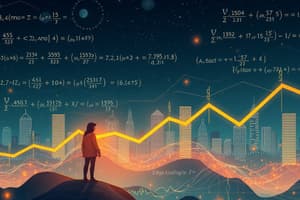Podcast
Questions and Answers
During an economic recession, which type of unemployment is most likely to increase significantly?
During an economic recession, which type of unemployment is most likely to increase significantly?
- Structural unemployment, due to long-term mismatches between skills and available jobs.
- Frictional unemployment, as more people voluntarily change jobs.
- Seasonal unemployment, which fluctuates with predictable industry cycles.
- Cyclical unemployment, caused by a decrease in overall demand for labor. (correct)
If the number of unemployed individuals is 5 million and the number of participants in the labor force is 120 million, what is the unemployment rate?
If the number of unemployed individuals is 5 million and the number of participants in the labor force is 120 million, what is the unemployment rate?
- 8.3%
- 6.0%
- 4.2% (correct)
- 2.4%
Which government policy would be least effective in addressing structural unemployment?
Which government policy would be least effective in addressing structural unemployment?
- Investing in community colleges to provide retraining programs.
- Providing subsidies for companies to adopt new technologies.
- Implementing policies to protect industries from globalization. (correct)
- Offering tax incentives for businesses to relocate to areas with high unemployment.
How would a significant increase in automation across various industries most likely impact the types of unemployment?
How would a significant increase in automation across various industries most likely impact the types of unemployment?
Which scenario best exemplifies frictional unemployment?
Which scenario best exemplifies frictional unemployment?
Flashcards
Unemployment Rate
Unemployment Rate
The percentage of the labor force that is actively seeking employment but unable to find a job.
Frictional Unemployment
Frictional Unemployment
Unemployment due to normal job turnover; short-lived and 'healthy'.
Structural Unemployment
Structural Unemployment
Unemployment caused by a mismatch between skills and available jobs, often due to obsolescence or globalization.
Cyclical Unemployment
Cyclical Unemployment
Signup and view all the flashcards
Natural Rate of Unemployment
Natural Rate of Unemployment
Signup and view all the flashcards
Study Notes
- Macro
Unemployment Rate
- Determined using the equation: # of unemployed / # of participants
- The percentage of the labor force looking but cannot find a job
- A primary statistic of efficiency
Historical Examples of Unemployment Rates
- Great Depression (1930s): 22%
- Tech Boom (1990s): 4.8%
- Great Recession (2008): 10%
- COVID-19 (April 2020): 15%
- January 2025 National: 4.1%, Connecticut: 3%
Types of Unemployment
- Natural rate of unemployment is 5%, and the rate fluctuates around this number
Frictional Unemployment
- Considered "good"
- Normal turnover
- Results from people being let go, dismissed, or seasonal work
- Natural, short-lived, and "healthy" for moving labor to more efficient production
Structural Unemployment
- Considered "bad"
- Persisting unemployment
- Due to a lack of wanted things
- Little demand in the economy
- Caused by obsolescence and globalization
- Fixed by retraining, like community colleges
Cyclical Unemployment
- Considered "ugly"
- Radical unemployment
- People have skills and would be hired, but there is no demand
- Caused by economic downturn or recession
- Fixed by waiting for demand increase or government action
Studying That Suits You
Use AI to generate personalized quizzes and flashcards to suit your learning preferences.
Description
Explanation of the unemployment rate, its calculation, and historical examples such as the Great Depression and the COVID-19 pandemic. Covers the types of unemployment: frictional, structural and cyclical. It also includes the natural rate of unemployment.




